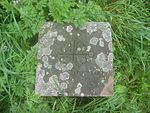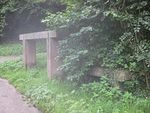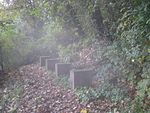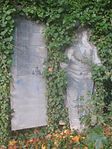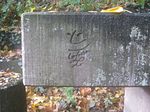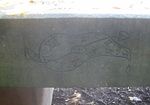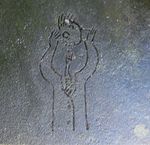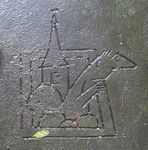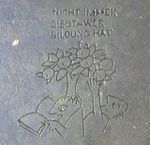In the Keuper
| In the Keuper | |
|---|---|
| Surname | In the Keuper |
| object | Landscape architectural installation |
| Artist | Hans Dieter Bohnet |
| Landscape architecture | Hans Luz |
| execution | ? |
| Construction year | 1993 |
| location | Stuttgart , Wartberg |
| Height above sea level | approx. 315 m |
| material | Keuper, Greek marble |
| Dimensions | Keuperwand: * Width: approx. 16 m * Height: approx. 4–5 m Length of the marble ice: approx. 1.70 m |
In the Keuper is a landscape architectural installation by the sculptor Hans Dieter Bohnet and the landscape architect Hans Luz on the Wartberg site in Stuttgart.
The installation is spread over two levels. The lower level was designed by Hans Dieter Bohnet and consists of a Keuper wall with a negative egg shape and a marble egg as well as a rock spring. The upper level on St.-Louis-Weg is extended to the Keuperwand as a viewing platform and is occupied on the slope with various Keuper objects designed by Hans Luz ( Ruhbank , rest areas, wine press , poetry stations characteristics of the Swabians ). The art station Im Keuper is followed further east by the stations Unter den Stangen and the Grottenloch .
The Art Station Im Keuper is one of the art stations that were built for the International Horticultural Exhibition 1993 (IGA '93) in the park landscape of the Green U in Stuttgart and were retained after the exhibition. In addition to this station, Hans Dieter Bohnet also created the neighboring art station Unter den Stangen as well as the fountains and floor sculptures of the Egelsee art station .
Note: Numbers in brackets, e.g. B. (12), refer to the corresponding numbers in the plan of the Wartberg area.
location
The Art Station Im Keuper (4) is on a slope of the Wartberg , probably on the site of an earlier sandstone quarry. In the east there is the art station Unter den Stangen (5), also by Hans Dieter Bohnet, and in the valley the art station Grottenloch by Michael Singer (6).
The Wartberg is located in the Stuttgart-Nord district of Stuttgart and functions within the Green U , a closed green space eight kilometers in length, as a link between the Leibfriedschen Garten and Rosensteinpark in the east and the Höhenpark Killesberg in the west.
Note: Keuperbach (12), Stangenbach (13) and Egelbach (14) are not official names, but rather serve to distinguish nameless streams on the Wartberg.
Access
The art station can u. a. can be reached in the following ways (also suitable for the disabled):
- From the Löwentorbrücke tram stop (20), follow the stairs to the Bombaystegen (21), then the left branch of the Menzel-Bourgiba-Weg (22) and finally the Straßburger Weg (23) to the art station.
- From the Höhenpark Killesberg you can take the St.-Helens-Steg (19) or the Cardiffer-Steg (18) to the St.-Helens-Weg (17) and on this to the art station.
description
The "Landscape Representation" (Hans Luz) in Keuper (4) was created in collaboration between the sculptor Hans Dieter Bohnet and the landscape architect Hans Luz and his office. The stage-like landscape panorama leans against the steep slope of a former sandstone quarry below St.-Louis-Weg (24) and falls in terraced steps to the east to Straßburger Weg (23), where the terrain in further terraces into the art station Unter den Stangen (5) and then ends in the valley through the Grottenloch art station (6).
The art station is “a tribute to the geological formation on which large quantities of Swabian wine grow”. The area where reed sandstone was broken in the Wartberg can no longer be located. It is assumed that the quarry was roughly where the Keuperwand is now installed. "It is intended to remind of this time and make the geological formation of the Keuper visible, similar to what the red quarry walls in the valley of the roses of the Killesberg do."
The art station is spread over two levels:
- The lower level consists of a high Keuper wall with a marble egg in front of it, which leans against the slope and ends in lower retaining walls, and an artificial rock spring from which the Keuperbach (12) rises. The terraced area in front of the Keuperwand is flanked by stairs that connect the St.-Louis-Weg with the Straßburger Weg.
- On the upper level, the St.-Louis-Weg towards the Keuperwand has been developed as a viewing platform. On the opposite slope side of the path there is a quiet bench , several resting places, a wine press , the poetry stations Characteristics of the Swabians and the "Industrialization" wall chart.
Lower level
Keuperwand
The center of the lower level forms an artificial wall that clad the formerly neglected steep slope with blocks of Maulbronn reed sandstone and ends with a viewing platform at the top on St. Louis-Weg. “The largest block into which the egg mold was supposed to be worked shattered when it was set up. This unforeseen condition now gives the impression that the egg lying in front of the wall on the terrace had "blown up" from the wall. "The approximately 1.70 m long, polished marble egg (popularly" Dino egg ") ) lies like in a nest on a slightly raised piece of lawn. An unnamed author on the website of the city of Stuttgart aptly characterized the relationship between Keuperwand and marble egg: “The marble egg and the negative shape of the egg in the wall were added by the sculptor Bohnet. As if the wall had given birth to the egg! A cuckoo's egg, because the egg and wall consist of different types of rock. Here the artist is the creator who has subjugated the rock and thus refers to the decision of man to design and change landscapes. "
The Keuperwand is flanked on both sides by retaining walls made of bulky Keuper blocks, which are laid on top of each other in two layers and reach about half the height of the wall. At the end of the left retaining wall, a long staircase leads up from Straßburger Weg to St.-Louis-Weg, on the right a short staircase leads from Keuperwand up to St.-Louis-Weg and the viewing platform. The terrace in front of the Keuperwand ends with a low dry stone wall and turns into a second terrace, which is supported by another wall against the slope.
Rock spring
The retaining wall of the second terrace in front of the Keuperwand ends on the right in a staircase that leads to an artificial rock spring. Two high Keuper blocks, between which the Keuperbach (12) rises, and two lower retaining walls made of massive cuboids form a semicircular scene. The brook runs left through the meadow in an easterly direction down to the grotto hole. A riding staircase leads down in several flat steps to the Straßburger Weg. The rock spring is followed by a staircase that leads up to St. Louis Way. The slope next to it, terraced by three dry stone walls, also ends with the St. Louis Way.
Upper level
The upper level runs along St. Louis Weg (24). It has been expanded into a viewing platform towards the Keuperwand. Several Keuper objects are lined up on the slope side of the path.
Viewing platform
At the upper edge of the Keuperwand the St.-Louis-Weg bulges to a partially paved viewing platform, which is secured by a steel railing with wire mesh. A stone with a stylized compass rose shows the cardinal points through a cross with hearts in between.
Slope side
On the slope side of St.-Louis-Weg, between the Straßburger Weg and the St.-Helens-Weg, there is a quiet bench , several resting places, a wine press , the poetry stations characteristics of the Swabians and the "Industrialization" wall chart.
Location map
Strasbourg way
- Ruhbank
- Round seating area
- Drink
- Create
- Wine press
- stairway
- Half-finished seating group
- Save up
- Musing
- Seating group "Insignia of the State of BW"
- Love
- World spirit
- Wooden bench
St. Helens Way
- "Industrialization" chart
- Schematic site plan of
the objects on St.-Louis-Weg
between Straßburger Weg
and St.-Helens-Weg
(blue: poetry stations characteristics of the Swabians ).
Ruhbank
At the confluence of the stairs that connect the Straßburger Weg with the St.-Louis-Weg, you come across a reconstructed resting bench, which is supposed to remind of the porters who used to hike up or down the Wartberg and take a rest on benches. They could put their burdens on the high bench and relax on the low (here almost overgrown) bench.
Resting places
The resting bench is followed by a stone seating group with a round table and round stools. To the right of it is the poetry station Drinking , and a little further to the right, behind the wine press, to the left of a stone bench in the bushes is the poetry station Schaffen .
Before the confluence of the St.-Louis-Weg and the St.-Helens-Weg you come across a staircase that leads through a clearing up the slope to a small wooded area. On the left there are the stone pedestals of a rectangular table and a bench, which are missing the tabletop and seat. The poetry station Sparen is located next to the half-finished seating group . On the right, a wide wooden bench invites you to linger. The world spirit poetry station is at the bank . On the slope, halfway between the unfinished seating area and the wooden bench, the lyric station Lieben is installed under a solitary tree .
The rest areas also include a stone seating group with comic engravings, see the insignia of the state of BW .
Wine press
Hans Dieter Bohnet designed a stylized wine press to commemorate earlier times when viticulture was still flourishing on the Wartberg. On the wooden toggle it bears the incisions "93", the year of the International Horticultural Exhibition 1993 (IGA '93), the slogan "It's not all evening yet", the signature "Bohnet 91" and the carved relief of a grape. The rotary lever and spindle of the press are made of bronze, the base of concrete.
The "Industrialization" chart also reminds of the earlier viticulture. Another throwback to Wengerter times is the small artificial Vineyard (15) at the junction of St Helens land for Wartberg. Behind the wine press, to the left of a stone bench, is the Schaffen poetry station .
"Industrialization" chart
Close to the confluence of St.-Louis-Weg and St.-Helens-Weg, a staircase leads to the "Industrialization - Between Forest and Vines" chart, which shows the gradual decline in viticulture in Stuttgart due to the emergence of Pietism and above all explained in the course of industrialization . Next to the wall chart is a "cardboard comrade" with the silhouette of a man who represents a wench in his Sunday best, but perhaps also an industrial worker.
Insignia of the state of BW
A short stone staircase on St.-Louis-Weg leads to a sheltered rest area that nestles in a corner on the edge of the forest. The square invites you to linger with a rectangular stone table and six stone stools. The poetry station Sinnieren is installed in front of the seating group .
The table top and the edges of the stone table have comic drawings based on designs by the graphic artist Hanns Lohrer. Lohrer mischievously titled his engravings " Insignia of the State of BW". BW stands for Baden-Württemberg and at the same time for “pretzel + wine”, the “staple food of Swabia”, which, according to Lohrer, was the inspiration behind the founding of the state. The wine is represented by Swabian quarter glasses, which, like the pretzels, are brought to life by funny faces reminiscent of smileys. There are also some corkscrew variants (as an important tool for the Swabian quarter-rider), a Dali clock and bizarre comics with and without funny sayings.
Because the table is exposed to wind and weather, not all of the engravings are well preserved, and the engravings on the tabletop are covered with leaves or snow in autumn and winter. If you want to get a clear picture of Lohrer's pretzel and wine comics, you will find extensive illustrative material and a selection of relevant texts in his compendium of the Swabian insignia Die Brezel & das Viertele .
concept
Hans Dieter Bohnet based his installation on the following considerations:
“At selected locations in the newly developed IGA area of the Wart and Steinberg, the planning landscape architect [Hans Luz] has set stations as target and stopping points and given them names like: ' Bei der Buche ', ' Grottenloch ' and ' Unter den Stangen' '. This is also the case with the 'Keuper' station, where a former quarry behind it should be visible again. "
“The existing neglected steep slope offered itself due to the new routing and stairway connection. With 'Keuper', a geological layer, the development of landscape and city is connected accordingly. Many buildings can still be seen in the Stuttgart cityscape today, which were built in earlier times with the material broken here. Becoming - in which man and nature are involved - was the reason for my spontaneous formal idea 'egg' (positive and negative) as the most succinct formulation for developing life. I resorted to this again when further processing the somewhat changed terrain situation. "
literature
- Rebekka Bücheler: Hans Dieter Bohnet, Kubus 1978 . In: Bärbel Küster (Ed.); Wolfram Janzer (photos): Sculptures of the 20th century in Stuttgart . Heidelberg 2006, pp. 74-77, here: 76.
- Rolf Fischer: Stuttgart and the Green U. The park landscape from Killesberg to the palace gardens . Stuttgart 2003, pp. 18–95, here: 82.
- Christoph Gunßer: The international horticultural exhibition Iga Expo '93 in Stuttgart . In: Deutsche Bauzeitung db. Journal for architects and civil engineers 127.1993, issue 6, pp. 14–28, here: 6, 26.
- Hanns Lohrer (illustration); Monika Hirschle (Ed.): The pretzel & the quarter. Portrayed by Hanns Lohrer. Texts searched for and found by Monika Hirschle . Gerlingen 2001.
- Christof Luz, Hans Luz: overall planning time systems: The Green U . In: Garten + Landschaft 103.1993, issue 7, pp. 18–28, here: 19, 22, 28.
- Christof Luz, Hans Luz: Planning concept. Landscaping . In: Klaus-Jürgen Evert (editor): The permanent systems. IGA Stuttgart 1993 . Munich 1993, pp. 12-17, here: 13, 16.
- Hans Luz: Around the Green U . Manuscript, Stuttgart 2012.
- Villa Moser, Hans Dieter Schaal. Stangenwald, Hans Dieter Schaal. At the crossroads, Claus Bury . In: Md: interior, design, architecture 40.1994, issue 2, pp. 62–65, here: 65.
- Frank Werner (ed.); Christof Luz (essay); Hans Luz (essay): Art-Nature-Drama. Earthworks beyond the IGA 1993 Stuttgart . Stuttgart 1993, pp. [56-57].
swell
- "Merksteine" plan from Luz + Partner, No. 684 W3 210/10 M1 / 10 of July 7, 1992, August 26, 1992, September 14, 1992.
Web links
- Hans Dieter Bohnet: Im Keuper, 1993 . Website of the city of Stuttgart; accessed 2013.
Individual evidence
- ↑ Homepage of Luz Landschaftsarchitektur, Stuttgart .
- ↑ Keuperwand = wall below the viewing platform. The width corresponds to the width of the platform railing.
- ↑ The ten art stations that have been preserved are: Near the beech , Bienengarten , Egelsee , Gate of Hope , Grottenloch , Im Keuper, Sanctuarium , Stangenwald , Unter den Stangen , Villa Moser .
- ↑ The plan is based on an OpenStreetMap map.
- ↑ #Stuttgart 2013 .
- ↑ #Luz, Hans 1993 , p. 9.
- ↑ Reed sandstone is a formation of the Keuper .
- ↑ #Luz, Christof 1993.3, p. 13 .
- ↑ #Stuttgart 2013 .
- ↑ # Werner 1993.3 , p. [57].
- ↑ # Fischer 2003 .
- ↑ #Stuttgart 2013 .
- ↑ #Luz, Hans 2012 , p. 71.
- ↑ #Lohrer 2001 , back cover and p. 67.
- ↑ #Lohrer 2001 .
- ↑ # Werner 1993.3 , p. [57].
Coordinates: 48 ° 48 ′ 11.1 ″ N , 9 ° 10 ′ 29 ″ E





